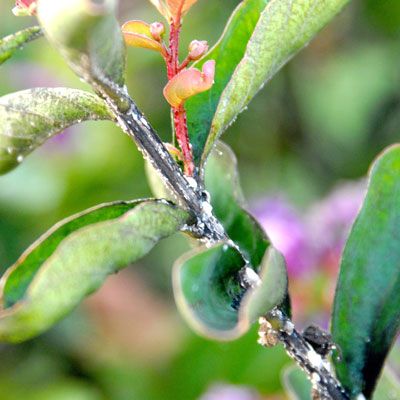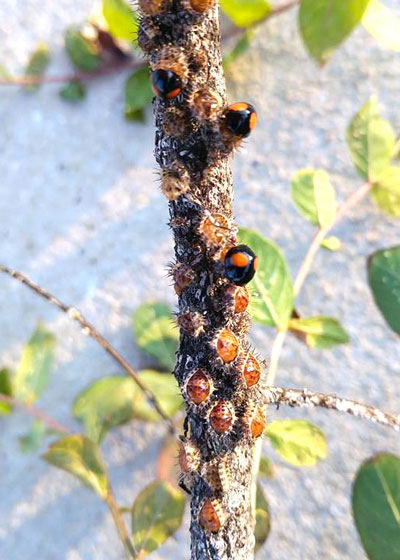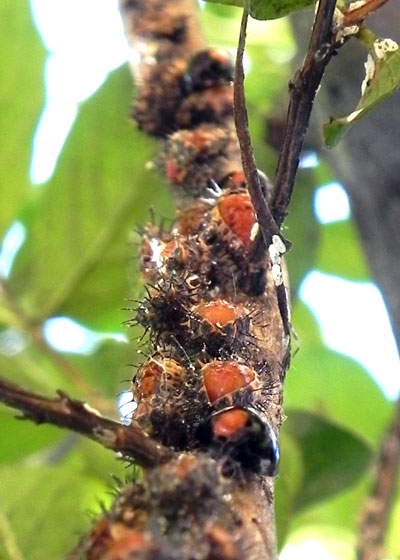Crape Myrtle Bark Scale
I’ve been heavily involved with crape myrtles for 40 years. After all, they’re the finest flowering shrubs in the South (personal opinion!). Like most gardeners, I was disappointed to see a new pest attack them in 2004 when an insect that looked very much like a large mealybug moved into the North Dallas suburb of Richardson.


It now appears that this species of scale was introduced to the U.S. from China. It is a known problem with their crape myrtles. Somehow it hitched a ride into the States.
My longtime friend Dr. Mike Merchant, entomologist with the Texas AgriLife Extension of Texas A&M, was brought into the picture very early, and he has done a great deal of research on this pest, now known as crape myrtle bark scale.
(Note that some use a one-word spelling of “crapemyrtle.” Plant taxonomists will tell you that common names have few rules, so both one- and two-word spellings are acceptable.)
Here are a few of my own observations from The Crape Myrtle Trails of McKinney where we have thousands of crape myrtles growing side by side.
• Bark scale was worst in 2007, a very wet June. Notably other scale insects were also bad on hollies, euonymus and other scale-prone plants that year.
• By the end of the summer, a natural predator, the twice-stabbed ladybug (so named because of the two orange-red spots on its wings) had become fairly common. It showed to be very efficient in eliminating many of the scales.


• Summers since 2007 have seen varying populations of bark scale. Of course, if you had scale on your own crape myrtles in any year, that made it a bad year for you, but in general terms, most summers since 2007 have seen lesser outbreaks.
• Initially the scale was seen only in Dallas and northward, also slightly to the east. People in Fort Worth and westward were essentially unaware of it for several years. In more recent years, however, it has spread quickly way east. Research involving 15 or more southern states is now underway trying to determine the best remedy for the insect.
Best control is prevention…
I spoke to Dr. Merchant late last week to get the most current thinking. Your time for prevention is now! Here are his guidelines.
• Scrub the trunks with a soft brush or sponge and soapy water to remove loose tissues and as many scale insects as possible.
• Apply a drench of either Imidacloprid or Dinotefuran mixed with several gallons of water in a bucket around the root system of the tree. Exact amount of water is not important, but you need to measure height of the crape myrtle and be precise in the amount of insecticide you include. (See directions in video link.)
• This treatment should be done right away in South Texas and by mid-May in North Texas. As much as possible you want it ahead of bloom time, as Mike explains in the video.
• This video was made 10 months ago and is still the current recommendation, pretty much as it has been for the past 6 or 7 years. Sprays, including dormant oils, are not as effective on crape myrtle bark scale.
My own personal observation, having worked with thousands of crape myrtles in the past 20 years: This scale and the resulting black sooty mold that develops in its sticky honeydew residue are not especially threatening to crape myrtles. However, they are very unappealing visually, so this preventive treatment is highly recommended.
All the rest of the details I will leave to Dr. Merchant’s video. Comments about the video after I posted this to my Facebook page were extremely complimentary saying how helpful it was to the viewers. I hope you find it useful as well.
Additional note… Entomologists and beekeepers tell me that they now feel that bee colony collapse, once thought to be brought on by systemic insecticides, seem instead to be the result of a complex collection of factors. Nonetheless, this is why the recommendation is for a soil drench instead of a spray and that it be made ahead of main bloom time.
